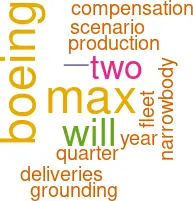MAX crisis:
Two scenarios
December 2019


Not quite the nadir for Boeing as we suggested in the last issue. 737 MAX production has now been suspended, the recertification process is still unclear, second quarter 2020 at earliest it seems, and Dennis Muilenburg was sacked as CEO.
Boeing ended 2019 (up to end November) with net orders of just 56 and deliveries of 345 commercial jets. Not that it was a particularly good year for Airbus either: 212 cancellations brought the net order total down to 718, and there were just 715 deliveries up to end-November against an original target of 960 for the year.
The ramifications of the MAX crisis extend far beyond the immediate performance of the two OEMs. There are two basic scenarios (with lots of gradations in between).
Scenario One implicitly underlies the various traffic forecasts made by IATA — that the 737 MAX operational issues are resolved, and production and deliveries resume, at least at some point in 2020. In the medium term the damage to Boeing’s reputation is contained, with confidence in the FAA’s role in certifying aircraft restored.
Boeing and its insurers will bear the large majority of the costs of the MAX grounding. Airlines and lessors will receive compensation for delivery delays allowing expansion plans to be resumed. Public confidence in the MAX may take some time to come back but, with rebranding and incident-free operations for some years, memories of the MAX accidents and the grounding will fade, as they did with historical problems afflicting the 727, DC-10, etc.
In summary, painful lessons will be learnt but the impact of the 737 MAX grounding will probably not be perceptible in the long-term perspective.
Scenario two is at the opposite extreme. Unable to remedy the MCAS faults to the satisfaction of its customers and the regulatory bodies, Boeing is forced to cancel the MAX programme, which would have nightmarish financial and strategic impacts.
As well as the compensation due relating to the two accidents and delays — $10bn? — the manufacturer would face the prospect of returning deposits and Pre-Delivery Payments (PDPs) taken from orderers (and which are calculated as percentages of the list price not the discounted actual price) plus the costs of cancelling parked MAXes — in total $50bn as a guess. But Boeing, having used most of the debt it has raised over the past year to pay dividends and make share buy-backs, has a weakened balance sheet, in fact negative equity of about $3.8bn as at the end of the third quarter (Aviation Strategy, November 2019).
The implication, bizarre as it may seem, is that the US government would have to have to intervene to organise a financial restructuring, maybe splitting Boeing up into component parts. Apart from the military implications for Washington, there is also the boost that this catastrophe would give to the nascent Chinese airframe manufacturing industry.
As for the airline and lessor customers, would they have to worry not only about compensation but also recovering their PDPs? All-Airbus operators might suddenly find themselves in a very favourable position, but how could the industry as a whole achieve its growth plans? According to the projections shown on this page PROJECTED BOEING NARROWBODY FLEET MAXes were expected to account for over half of the operating Boeing narrowbody fleet, and a quarter of the global narrowbody fleet, by 2029.
An all-new Boeing model will take, maybe, ten years to certification, while Airbus does not look as if it can fill the production gap. This means retention of older types in the global fleet, which means, among other things, that carbon emission targets will be much harder to meet.
Apologies for this unseasonal speculation. Scenario one is still much more probable than two, but the latter has to be considered.
| 737 | 747 | 767 | 777 | 787 | Total | |
|---|---|---|---|---|---|---|
| Orders | 68 | 26 | 38 | 111 | 243 | |
| Cancellations | -119 | -41 | -27 | -187 | ||
| Net orders | -51 | 0 | 26 | -3 | 84 | 56 |
| Deliveries | 121 | 7 | 40 | 40 | 137 | 345 |
| Backlog | 4,591 | 17 | 97 | 388 | 569 | 5,662 |
| Net orders 2018 | 580 | 6 | 27 | 48 | 145 | 806 |
| A220 | A320 | A330 | A350 | A380 | Total | |
|---|---|---|---|---|---|---|
| Orders | 12 | 751 | 64 | 113 | 940 | |
| Cancellations | -5 | -91 | -8 | -48 | -70 | -222 |
| Net orders | 7 | 660 | 56 | 65 | -70 | 718 |
| Deliveries | 31 | 537 | 45 | 96 | 6 | 715 |
| Backlog | 432 | 6,193 | 306 | 628 | 11 | 7,570 |
| Net orders 2018 | 20 | 626 | 49 | 93 | 12 | 800 |
Source: ESG Airline Monitor